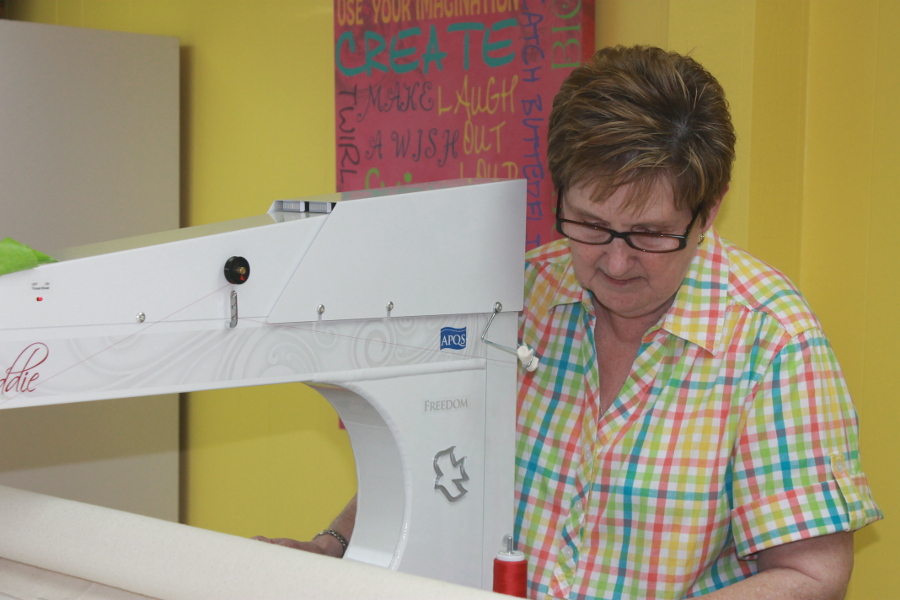How much to charge when longarm quilting for others
With an APQS longarm quilting machine, it’s easy to put some extra money in your pocket by quilting for others. In fact, depending on your goals, it’s possible to pay off your investment within a single year! Even if you purchased a longarm quilting machine just for your own quilts, it doesn’t take long for someone to find out and ask if you could, just this once, quilt their quilt! Of course you can always say no … but if you suddenly find yourself saying “yes,” it helps to know how to price your work.
You do not need to be an expert at all quilting techniques and styles to successfully quilt for others. With just a few simple skills in your wheelhouse you can start earning nearly immediately. When setting your prices for quilting, it’s important to look at the entire process and not base your price simply on what others are charging in your area—especially if it is more than just a hobby for you.
First determine what you’d like to earn as your “hourly wage.” Will this be a full-time business, a part-time retirement income, or are you just interested in earning enough to buy more fabric for your own quilts? Decide what your time is worth so that you can develop a pricing plan to meet your needs.

Start by evaluating your “overhead” costs. Your price should account for these expenses, including:
- Your machine investment
- Supplies (thread, batting, backing fabric)
- Utilities (phone, electricity, heat/air, water, even pest control)
- Rent
- Insurance (for both your machine and the quilts that belong to others)
- Professional fees (attorney, accountant, etc.)
- Advertising
Next calculate the “prep time” it takes to complete a quilt that isn’t specifically spent on the actual quilting. Many professional quilters forget to add this time to their pricing and end up making much less than they originally expected.
Keep a log book whenever you do a quilt and time how long it takes to complete each facet of the process. Some quilts will take you much longer than others, but over time you’ll start to see a pattern develop based on the size of quilt or the style of quilting you are doing. This “average prep time” should be factored into your overall price, and would include things like:
- Consultation time and quilt pick-up time
- Quilt loading time
- Design planning
- Patching and repair
- Thread trimming
- Backing and batting preparation
- Bobbin winding
- Billing and accounting
Next you’ll need to calculate how long the actual quilting process will take you. Many quilters make the mistake of charging the same price for all pantograph designs. It doesn’t take long to learn that denser designs take much longer to complete than simple, open patterns. Yet if you charge the same price for all designs, you’ll make much less per hour than your goal.

Instead, time how long it takes you to do a single repeat of your pantograph design and record the minutes. Do this for each size of quilt so that you know how long one repeat will take for that particular size. Once you know that number, all you need to do is determine how many rows of that design you will need to complete the quilt.
For example, if your pantograph is 10 inches tall and you have a queen-size quilt that is 100” x 100,” at least 10 rows of your pantograph will be needed to finish the quilt. If one pass for the pattern takes 30 minutes to reach the queen-size repeat, then multiply that times 10. In this example, quilting that design will take 5 hours.
Next add in the quilt prep time you calculated earlier (consultation, pressing, loading, etc.) to determine the true quantity of time the quilt will take, along with the overhead expenses associated with producing one quilt. In the example above, let’s say that you met with your customer for an hour, and that it took you an hour to prep and load the quilt. You’re now up to 7 hours of time.
Finally, look at the hourly wage you want to earn and “do the math.” If you want to earn $25 per hour, then you should charge $175 for the quilt in our example (not including batting and thread). Most longarm quilters charge by the “square inch” for quilting services. That means you’d need to charge 1.75 cents per square inch (or $0.0175 ) for that pattern to earn your projected hourly wage.
Use this process with each design you own to determine how to properly charge for your work. Instead of having a “one size fits all” price for pantographs that could potentially lose you money, develop 2-4 pricing categories that ensure you are earning what you expect. You can have a collection of simple patterns for the budget-conscious quilter along with more complex designs to suit a variety of tastes.
Are you curious about what you could earn quilting for others? Check out how an APQS machine can bring you a return on your investment by clicking here. Learn more about starting a longarm business by getting our free sample business plan to help you on your way!



